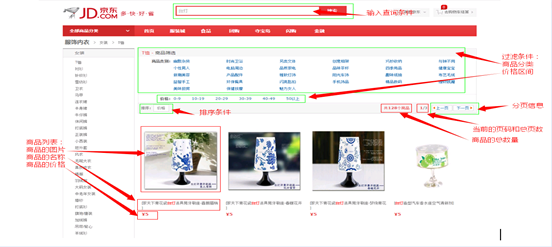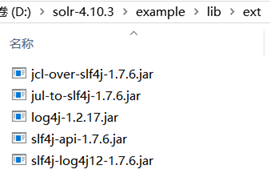1. 综合案例
1.1. 需求
使用Solr实现电商网站中商品信息搜索功能,可以根据关键字、分类、价格搜索商品信息,也可以根据价格进行排序,并且实现分页功能。
界面如下:

1.2分析
开发人员需要的文档:静态页面(根据UI设计由美工给出)、数据库设计、原型设计
1.2.1 UI 分析

1.2.2 架构分析

架构分为:
(1)、solr服务器。(已经做完,同入门示例)
(2)、自己开发的应用(重点)
(3)、数据库mysql
自己开发的应用
Controller 负责和前端页面进行请求和响应的交互
Service 封装查询条件,调用dao。
Dao 搜索索引库,返回搜索结果。
1.3. 环境准备
Solr:4.10.3
Jdk环境:1.7.0_72(solr4.10 不能使用jdk1.7以下)
Ide环境:Eclipse
Web服务器(servlet容器):Tomcat 7+
1.4 代码实现
1.4.1. 实现步骤
第一部分:SpringMVC框架搭建
第二部分:整合Spring与Solr (Solr服务已经搭建好了)
第三部分:实现功能
1.4.2. 实现步骤
1.4.2.1. 第一部分:SpringMVC框架搭建
--新建一个动态网站项目导入SpringMVC的Jar包
第一步:导入SpringMVC依赖包

1.4.2.2.. 第二步:创建一个请求页面
1 <%@ page language="java" contentType="text/html; charset=UTF-8" 2 pageEncoding="UTF-8"%> 3 <!DOCTYPE html> 4 <html> 5 <head> 6 <meta charset="UTF-8"> 7 <title>Insert title here</title> 8 </head> 9 <body> 10 11 <a href="${pageContext.request.contextPath }/say">say hello</a> 12 </body> 13 </html>
1.4.2.3 第三步:web.xml配置(入口)
1 <?xml version="1.0" encoding="UTF-8"?> 2 <web-app xmlns:xsi="http://www.w3.org/2001/XMLSchema-instance" 3 xmlns="http://xmlns.jcp.org/xml/ns/javaee" 4 xsi:schemaLocation="http://xmlns.jcp.org/xml/ns/javaee http://xmlns.jcp.org/xml/ns/javaee/web-app_3_1.xsd" 5 id="WebApp_ID" version="3.1"> 6 <display-name>solr-demo-02-jd</display-name> 7 <!-- 配置编码过滤器 --> 8 <filter> 9 <filter-name>characterEncodingFilter</filter-name> 10 <filter-class>org.springframework.web.filter.CharacterEncodingFilter</filter-class> 11 <!-- 指定编码 --> 12 <init-param> 13 <param-name>encoding</param-name> 14 <param-value>UTF-8</param-value> 15 </init-param> 16 </filter> 17 <filter-mapping> 18 <filter-name>characterEncodingFilter</filter-name> 19 <url-pattern>/*</url-pattern> 20 </filter-mapping> 21 <!-- 核心控制器 --> 22 <servlet> 23 <servlet-name>dispatcherServlet</servlet-name> 24 <servlet-class>org.springframework.web.servlet.DispatcherServlet</servlet-class> 25 <!-- 读取指定的配置文件 --> 26 <init-param> 27 <param-name>contextConfigLocation</param-name> 28 <param-value>classpath:spring-*.xml</param-value> 29 </init-param> 30 <!-- 随web server启动 --> 31 <load-on-startup>1</load-on-startup> 32 </servlet> 33 <servlet-mapping> 34 <servlet-name>dispatcherServlet</servlet-name> 35 <url-pattern>/</url-pattern> 36 </servlet-mapping> 37 38 </web-app>
1.4.2.4 第四步:配置Spring配置文件
1 <?xml version="1.0" encoding="UTF-8"?> 2 <beans xmlns="http://www.springframework.org/schema/beans" 3 xmlns:xsi="http://www.w3.org/2001/XMLSchema-instance" 4 xmlns:mvc="http://www.springframework.org/schema/mvc" 5 xsi:schemaLocation="http://www.springframework.org/schema/mvc http://www.springframework.org/schema/mvc/spring-mvc-4.3.xsd 6 http://www.springframework.org/schema/beans http://www.springframework.org/schema/beans/spring-beans.xsd"> 7 8 <!-- 启动注解默认支持 --> 9 <mvc:annotation-driven /> 10 <!-- 放开默认静态资源访问 --> 11 <mvc:default-servlet-handler/> 12 13 <!-- 配置视图解释器 --> 14 <mvc:view-resolvers> 15 <mvc:jsp prefix="/" suffix=".jsp"/> 16 </mvc:view-resolvers> 17 18 19 </beans>
--context配置文件,spring-context.xml
<?xml version="1.0" encoding="UTF-8"?> <beans xmlns="http://www.springframework.org/schema/beans" xmlns:xsi="http://www.w3.org/2001/XMLSchema-instance" xmlns:context="http://www.springframework.org/schema/context" xsi:schemaLocation="http://www.springframework.org/schema/beans http://www.springframework.org/schema/beans/spring-beans.xsd http://www.springframework.org/schema/context http://www.springframework.org/schema/context/spring-context-4.3.xsd"> <!-- 扫描组件配置 --> <context:component-scan base-package="org.chu"></context:component-scan> </beans>
1.4.2.5 第五步:配置业务控制器
1 @Controller 2 public class PageController { 3 4 @RequestMapping(value="/{page}") 5 public String showPage(@PathVariable String page) { 6 System.out.println("-HelloWorld:"+page); 7 return page; 8 } 9 10 }
1.4.2.6 第六步:配置返回页面
1 <%@ page language="java" contentType="text/html; charset=UTF-8" 2 pageEncoding="UTF-8"%> 3 <!DOCTYPE html> 4 <html> 5 <head> 6 <meta charset="UTF-8"> 7 <title>Insert title here</title> 8 </head> 9 <body> 10 你好世界 11 </body> 12 </html>
第二部分:整合Spring与Solr
注意事项:
必须要将Solr的Tomcat服务器的端口配置与项目运行的Tomcat的端口不一样。因为如果在同一个电脑上同时运行两个Tomcat,端口不修改就会冲突。
第一步:修改Solr服务器端口
前提:Solr服务器已经准备好。
--Tomcat的conf/server.xml文件中,修改端口
--tomcat端口说明:
8005:关机端口, 修改为:8006
8080:默认服务端口,修改为 :8888
8009:请求转向端口,修改为:8010
第二步:导入Solr的连接依赖包
--将以下的jar 加入到项目的WEB-INF/lib里面。
--日志处理包

--solrj依赖包

第三步:加入Log4j的支持
在classpath根目录加入lo4j.properties。该文件可以在solr的包里面找到

第四步:在spring-context.xml配置Solr
<!-- 配置Solr整合的连接对象 --> <bean name="solrServer" class="org.apache.solr.client.solrj.impl.HttpSolrServer"> <!-- 通过构造方法指定请求的路径 --> <constructor-arg index="0" value="http://localhost:8888/solr/soreCore0225" /> </bean>
第三部分:功能实现
第一步:导入页面资源
--将准备的资料放在webapp,网站根目录。并且删除原来测试的页面,test.jsp以及say.jsp。
结果如下:

第二步:导入JSTL的支持

第三步:编写JavaBean
1 public class Product { 2 // 商品编号 3 private String pid; 4 // 商品名称 5 private String name; 6 // 商品分类名称 7 private String catalogName; 8 // 价格 9 private double price; 10 // 商品描述 11 private String description; 12 // 图片名称 13 private String picture; 14 //补全get、set方法 15 }
--业务模型(Value Object VO),编写ResultModel业务模型
1 import java.util.List; 2 3 public class ResultModel { 4 5 private List<Product> productList; 6 // 商品总数 7 private Long recordCount; 8 // 总页数 9 private int pageCount; 10 // 当前页 11 private int currentPage; 12 //补全get、set方法 13 14 }
第四步:获得Solr的数据
1 import java.util.ArrayList; 2 import java.util.List; 3 import org.apache.solr.client.solrj.SolrQuery; 4 import org.apache.solr.client.solrj.impl.HttpSolrServer; 5 import org.apache.solr.client.solrj.response.QueryResponse; 6 import org.apache.solr.common.SolrDocument; 7 import org.apache.solr.common.SolrDocumentList; 8 import org.chu.dao.ProductDAO; 9 import org.chu.pojo.Product; 10 import org.chu.pojo.ResultModel; 11 import org.springframework.beans.factory.annotation.Autowired; 12 import org.springframework.stereotype.Repository; 13 @Repository 14 public class ProductDAOImpl implements ProductDAO{ 15 @Autowired 16 private HttpSolrServer solrServer; 17 @Override 18 public ResultModel queryProduct(SolrQuery query) throws Exception { 19 20 //创建一个返回的业务模型对象 21 ResultModel resultModel=new ResultModel(); 22 //第一步:获得Solr响应对象 23 QueryResponse response = solrServer.query(query); 24 //第二步:获得返回的结果集 25 SolrDocumentList results = response.getResults(); 26 //第三步:将SolrDocumentList集合对象转成List<Product> 27 List<Product> products=new ArrayList<>(); 28 // 设置高亮信息 29 Map<String, Map<String, List<String>>> highlighting = response.getHighlighting(); 30 for (SolrDocument solrDocument : results) { 31 Product product=new Product(); 32 product.setPid((String)solrDocument.get("id")); 33 // 设置高亮信息 34 List<String> list = highlighting.get(solrDocument.get("id")).get("product_name"); 35 36 String prodName = (String) solrDocument.get("product_name"); 37 if (list != null)prodName = list.get(0); 38 product.setName(prodName); 39 product.setCatalogName((String) solrDocument.get("product_catalog_name")); 40 product.setPicture((String) solrDocument.get("product_picture")); 41 product.setDescription((String) solrDocument.get("product_description")); 42 product.setPrice((Double) solrDocument.get("product_price")); 43 products.add(product); 44 } 45 //第四步:将数据封装到ResultModel 46 //总记录书 47 resultModel.setRecordCount(results.getNumFound()); 48 //查询的的结果 49 resultModel.setProductList(products); 50 return resultModel; 51 } 52 }
第五步:构造Service
import org.apache.solr.client.solrj.SolrQuery; import org.apache.solr.client.solrj.SolrQuery.ORDER; import org.chu.dao.ProductDAO; import org.chu.pojo.ResultModel; import org.chu.service.ProductService; import org.springframework.beans.factory.annotation.Autowired; import org.springframework.stereotype.Service; @Service public class ProductServiceImpl implements ProductService { @Autowired private ProductDAO productDAO; @Override public ResultModel queryProduct(String queryString, String cataName, String price, String sort, Integer curPage) throws Exception { //构建查询的条件 SolrQuery query=new SolrQuery(); //判断关键字不为空 if (queryString!=null&&!"".equals(queryString)) { query.set("q", queryString); }else { query.set("q", "*:*"); } //增加过滤条件 if (cataName!=null&&!"".equals(cataName)) { query.addFilterQuery("product_catalog_name:"+cataName); } //价格过滤 if (price!=null&&!"".equals(price)) { String[] prices = price.split("-"); query.addFilterQuery("product_price:[ "+prices[0]+" TO "+prices[1]+" ]"); } //排序,1:desc ,非1就,asc if (sort!=null&&sort.equals("1")) { query.setSort("product_price", ORDER.desc); }else{ query.setSort("product_price", ORDER.asc); } //设置分页 //如果没有值,就为第一页 if (curPage==null) { curPage=1; } //设置查询的开始位置 query.setStart((curPage-1)*20); //设置每页记录数 query.setRows(20); query.set("df", "product_name"); //高亮分词设置 query.setHighlight(true); //设置高亮的字段 query.addHighlightField("product_name"); //通过标签设置颜色 //开始标签 query.setHighlightSimplePre("<font style="color:red">"); query.setHighlightSimplePost("</font>"); ResultModel resultModel = productDAO.queryProduct(query); //返回结果后,封装请求的数据到业务模型里面 resultModel.setCurrentPage(curPage); // 总页数 = 总数量 / 每页数据条数 结果向上取整 double ceil = Math.ceil(resultModel.getRecordCount().doubleValue()/20); resultModel.setPageCount((int)ceil); return resultModel; } }
构建Controller
import org.chu.pojo.ResultModel; import org.chu.service.ProductService; import org.springframework.beans.factory.annotation.Autowired; import org.springframework.stereotype.Controller; import org.springframework.ui.ModelMap; import org.springframework.web.bind.annotation.RequestMapping; import org.springframework.web.bind.annotation.RequestParam; @Controller public class ProductController { @Autowired private ProductService productService; @RequestMapping(value="/list") public String list(String queryString, @RequestParam("catalog_name") String catalogName,String price, String sort, Integer curPage, ModelMap model) { try { ResultModel resultModel = productService.queryProduct(queryString, catalogName, price, sort, curPage); model.addAttribute("result", resultModel); model.addAttribute("queryString", queryString); model.addAttribute("catalog_name", catalogName); model.addAttribute("price", price); model.addAttribute("sort", sort); model.addAttribute("page", curPage); } catch (Exception e) { e.printStackTrace(); } return "product_list"; } }